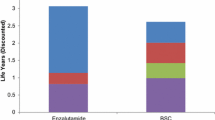Abstract
Several decision-analytic modeling techniques are in use for pharmacoeconomic analyses. Discretely integrated condition event (DICE) simulation is proposed as a unifying approach that has been deliberately designed to meet the modeling requirements in a straightforward transparent way, without forcing assumptions (e.g., only one transition per cycle) or unnecessary complexity. At the core of DICE are conditions that represent aspects that persist over time. They have levels that can change and many may coexist. Events reflect instantaneous occurrences that may modify some conditions or the timing of other events. The conditions are discretely integrated with events by updating their levels at those times. Profiles of determinant values allow for differences among patients in the predictors of the disease course. Any number of valuations (e.g., utility, cost, willingness-to-pay) of conditions and events can be applied concurrently in a single run. A DICE model is conveniently specified in a series of tables that follow a consistent format and the simulation can be implemented fully in MS Excel, facilitating review and validation. DICE incorporates both state-transition (Markov) models and non-resource-constrained discrete event simulation in a single formulation; it can be executed as a cohort or a microsimulation; and deterministically or stochastically.


Similar content being viewed by others
References
Howard RA. The foundations of decision analysis revisited. http://www.docdatabase.net/details-the-foundations-of-decision-analysis-revisited-1018284.html. Accessed 1 March 2016.
Metropolis N, Rosenbluth AW, Rosenbluth MN, Teller AH, Teller E. Equation of state calculations by fast computing machines. J Chem Phys. 1953;21:1087–92.
Berg BA. Introduction to Markov chain Monte Carlo simulations and their statistical analysis. In: Kendall WS, Liang F, Wanf J-S, editors. Markov Chain Monte Carlo: innovations and applications. Singapore, Hackensack: World Scientific; 2005.
Goldsman D, Nance RE, Wilson JR. A brief history of simulation revisited. In: Johansson B, Jain S, Montoya-Torres J, Hugan J, Yucesan, editors. Proceedings of the 2010 Winter Simulation Conference. Baltimore: Winter Simulation Conference Foundation; 2010.
Radzicki MJ, Taylor RA. Origin of system dynamics. Forrester JW. The history of system dynamics. In: US Department of Energy’s introduction to system dynamics. http://www.systemdynamics.org/DL-IntroSysDyn/start.htm. Accessed 1 March 2016.
Stahl JE. Modelling methods for pharmacoeconomics and health technology assessment: an overview and guide. Pharmacoeconomics. 2008;26:131–48.
Brennan A, Chick SE, Davies R. A taxonomy of model structures for economic evaluation of health technologies. Health Econ. 2006;15:1295–310.
McIntosh ME, Donaldson C, Ryan M. Recent advances in the methods of cost-benefit analysis in healthcare. Pharmacoeconomics. 1999;15:357–67.
Sullivan SD, Mauskopf JA, Augustovski F, Caro JJ, et al. Budget impact analysis: principles of good practice: report of the ISPOR 2012 Budget Impact Analysis Good Practice II Task Force. Value Health. 2014;17:5–14.
Nord E. The trade-off between severity of illness and treatment effect in cost-value analysis of health care. Health Policy. 1993;24:227–38.
Karlsson G, Johannesson M. The decision rules of cost-effectiveness analysis. Pharmacoeconomics. 1996;9:113–20.
Robinson R. Cost-utility analysis. BMJ. 1993;307:859–62.
Rochau U, Jahn B, Qerimi V, et al. Decision-analytic modeling studies: an overview for clinicians using multiple myeloma as an example. Crit Rev Oncol Hematol. 2015;94:164–78.
Siebert U, Alagoz O, Bayoumi AM, et al. State-transition modeling: a report of the ISPOR-SMDM Modeling Good Research Practices Task Force-3. Value Health. 2012;15:812–20.
Nutaro J, Kuruganti PT, Protopopescu V, Shankar M. The split system approach to managing time in simulations of hybrid systems having continuous and discrete event components. Simulation. 2012;88:281–98.
Roberts M, Russell LB, Paltiel AD, Chambers M, McEwan P, Krahn M, ISPOR-SMDM Modeling Good Research Practices Task Force. Conceptualizing a model: a report of the ISPOR-SMDM Modeling Good Research Practices Task Force-2. Value Health. 2012;15:804–11.
Briggs AH, Weinstein MC, Fenwick E, et al. Model parameter estimation and uncertainty: a report of the ISPOR-SMDM Modeling Good Research Practices Task Force-6. Value Health. 2012;15:835–42.
Eddy DM, Hollingworth W, Caro JJ, et al. Model transparency and validation: a report of the ISPOR-SMDM Modeling Good Research Practices Task Force-7. Value Health. 2012;15:843–50.
Caro JJ, Möller J, Karnon J, Stahl J, Ishak J. Discrete event simulation for health technology assessment. Boca Raton: Taylor & Francis; 2015.
Acknowledgments
The assistance of Jörgen Möller in developing the example DICE available online is much appreciated.
Author information
Authors and Affiliations
Corresponding author
Ethics declarations
Funding
No funding was received for the work reported in this paper.
Conflicts of interest
The author is an employee of a consultancy, Evidera, which develops pharmacoeconomic models. The DICE method is, however, freely available to anyone who wishes to use it, without restrictions.
Additional information
Supplementary file is a plain Excel workbook that has been locked to prevent inadvertent modification. In order to open the file, please obtain LockXLS runtime from http://www.lockxls.com/download.asp. Follow the instructions for downloading and installing the runtime version (either 32 or 64 bit, depending on your installation of Windows). Then, open the MS Excel workbook named DICEd2-02L.xlsm. Note, this version only works with Windows MS Excel.
Electronic supplementary material
Below is the link to the electronic supplementary material.
Rights and permissions
About this article
Cite this article
Caro, J.J. Discretely Integrated Condition Event (DICE) Simulation for Pharmacoeconomics. PharmacoEconomics 34, 665–672 (2016). https://doi.org/10.1007/s40273-016-0394-z
Published:
Issue Date:
DOI: https://doi.org/10.1007/s40273-016-0394-z




